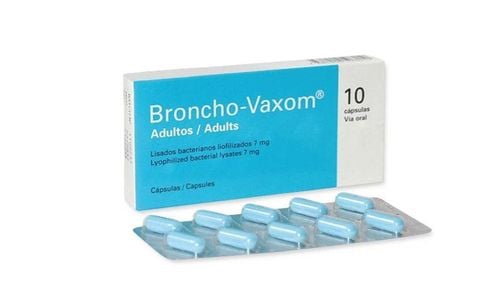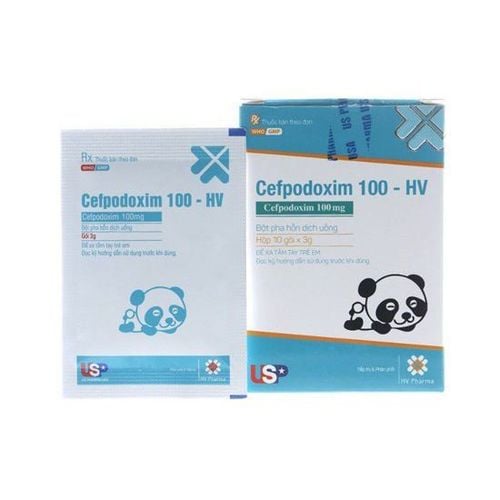This is an automatically translated article.
Lucass drug is made in the form of hard capsules, with the ingredient being Cefpodoxime proxetil - an antibiotic used in the treatment of respiratory, urinary, and skin infections,...
1. What are the effects of Lucass?
What is Lucas drug? The drug has the composition Cefpodoxime proxetil with the strength of 100mg, 200mg (Lucass drug 100mg, Lucas drug 200mg). Cefpodoxime proxetil is a 3rd generation cephalosporin antibiotic, which exerts antibacterial action through inhibition of bacterial cell wall synthesis.
Lucass 200 is indicated for use in the following cases:
Treatment of bronchitis; Treatment of community-acquired acute pneumonia; Treatment of tonsillitis , pharyngitis; Treatment of acute otitis media; Treatment of skin/skin structure infections; Treatment of uncomplicated urinary tract infections; Treatment of uncomplicated gonorrhea. Lucass is contraindicated in the following cases: Hypersensitivity to Cephalosporin antibiotics or components contained in the drug.
2. How to use and dose of Lucass
Usage: Orally.
Dosage in adults:
Pharyngitis, tonsillitis: Use dose of 100mg x 2 times/day (use dosage form suitable for dose division) for 5-10 days; Community-acquired acute pneumonia: 200mg x 2 times/day for 14 days; Acute exacerbation of chronic bronchitis: Dose 200mg x 2 times/day for 10 days; Skin and skin structure infections: 400mg twice daily for 7-14 days; Uncomplicated gonorrhea: 200mg dose, then treated with oral doxycycline to prevent Chlamydia infection; Uncomplicated urinary tract infections: Dose of 100mg x 2 times/day (use dosage form suitable for dose division) for 7 days. Dosage in children under 13 years old:
Acute otitis media: Use dose 5mg/kg (maximum 200mg) x 2 times/day for 10 days; Pharyngitis, tonsillitis: Use dose 5mg/kg (maximum 200mg) x 2 times/day for 5-10 days. Dosage for patients with renal impairment: The dose should be reduced according to the degree of renal impairment. For patients with a creatinine clearance less than 30ml/min and not on hemodialysis, the doses are usually spaced.
Overdose: In case of overdose, the patient can be hemodialysis or peritoneal dialysis to remove Cefpodoxime from the body.
Missed dose: If you forget to take a dose of Lucass, the patient should take it as soon as possible. If it is almost time for your next dose, skip the missed dose and take your next dose as scheduled.
3. Side effects of the drug Lucass
When using Lucass 200, patients may experience some unwanted side effects including:
Gastrointestinal: Pseudomembranous colitis syndrome occurs during or after taking the drug. Patients may experience symptoms of nausea, vomiting, flatulence, decreased secretions, diarrhea,...; Cardiovascular: Low blood pressure, chest pain; Skin: Skin peeling, fungal skin infections; Endocrine: Irregular menstruation; Genitourinary: Itching, discomfort; Hypersensitivity: Anaphylaxis ; Central nervous system: Fatigue, dizziness, nightmares, anxiety, insomnia, weakness; Respiratory: Cough, nosebleed ; Other side effects: Fever, irritability, itchy eyes, tinnitus, change in taste,... When experiencing the above side effects, users should stop using the drug, notify a doctor or go to a medical facility. nearest hospital to be examined and treated promptly.
4. Be careful when using the drug Lucass
Before and while taking Lucass 200, patients should note:
Before being treated with Lucass 200 (which contains Cefpodoxime proxetil), it is necessary to carefully investigate the patient's allergy history to group antibiotics. Cephalosporins, penicillins or other drugs. Caution should be exercised when administering the drug to patients with a history of allergy to beta-lactams, because cross-hypersensitivity reactions may occur; If an allergic reaction to Cefpodoxime proxetil occurs, the patient should stop taking the drug, initiate integrated therapy; Cefpodoxime proxetil should be used with caution in patients with severe renal failure and a history of gastrointestinal disease, especially colitis; Long-term use of Cefpodoxime proxetil may cause overgrowth of non-susceptible organisms, so careful monitoring of the patient is required. If superinfection occurs during treatment, appropriate therapy should be instituted; There are no adequate studies on the effectiveness and side effects of Lucass when used in pregnant women. Therefore, pregnant women should only use this drug when absolutely necessary, with a doctor's prescription; Cefpodoxime proxetil component may be secreted into breast milk, affecting the health of nursing infants. Therefore, the mother who is taking the drug should stop breastfeeding.
5. Lucas drug interactions
Some drug interactions of the drug Lucas 200 include:
Antacids: Concomitant use of Lucas with high-dose antacids (such as sodium bicarbonate, aluminum hydroxide) or H2 blockers will reduce drug levels in the blood. plasma from 24 - 42% and reduced absorption from 27 - 32%; Probenecid: As with other beta-lactam antibiotics, the renal excretion of cefpodoxime proxetil is inhibited by probenecid, increasing the AUC by approximately 30%, increasing the peak plasma concentration by 20%; Nephrotoxic Drugs: Although nephrotoxicity has not been detected in Cefpodoxime proxetil alone, renal function should be closely monitored when this drug is co-administered with other nephrotoxic drugs. other. When using Lucass 200, patients need to follow all instructions given by the doctor about the dose and how to take the drug. If adverse side effects occur, the patient should immediately notify the doctor for early intervention to ensure health.
Follow Vinmec International General Hospital website to get more health, nutrition and beauty information to protect the health of yourself and your loved ones in your family.
Please dial HOTLINE for more information or register for an appointment HERE. Download MyVinmec app to make appointments faster and to manage your bookings easily.













